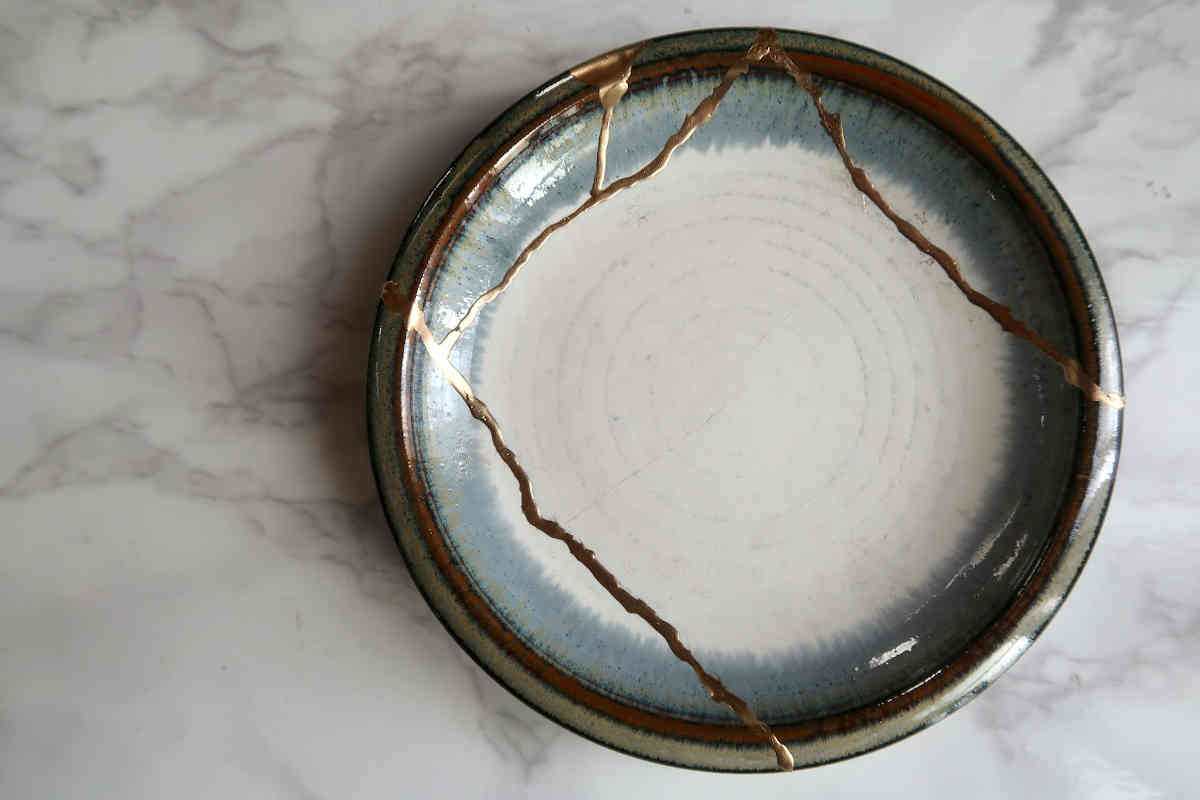We are often ashamed or embarrassed about our scars, both physical and mental, but there is beauty in scars. They are part of what makes us unique, they help mould our story. More often than not, we try to run away from them. By approaching the scars on your body and mind through the Japanese concept of kintsugi, you can embrace imperfections, bounce back from setbacks, accept the impermanence of life, and value yourself for who you are.
Understanding Kintsugi
Kintsugi is the Japanese art of repairing broken pottery, ceramic or porcelain, with lacquer that is dusted or mixed with powered gold. It is typically a slow process, one that carefully reassembles the shattered piece. It is both a way to preserve the piece and embrace the flaws and imperfections. The crack becomes part of its story. There is an appreciation for the new beauty that comes from the craftsmanship of the repair. The love that was poured into its reconstruction. It is also a reminder that nothing is forever, change is a part of life.
Using Kintsugi To Accept Our Physical Scars
Body image often affects how we feel about ourselves. People who have scars are often ashamed or embarrassed by them. A thrill seeker may be proud of a scar if they got it when doing something adventurous, but when a scar is from a medical procedure, often people hide it.
Let’s unpack the difference between these scenarios. The first came about from a decision you had control over, the second, not so much. It exposes vulnerability. It is a visible reminder that something was “wrong” with you. Nobody likes to admit they have limits. Sometimes those scars come from a horrible accident, so seeing it can be a trigger. Many may try to conceal their physical scars with the clothes they choose to wear, or by incorporating body modifications like tattoos or piercings. When none of those are possible, and in extreme cases, people isolate themselves out of fear of being judged.
Hiding physical scars could be indicative of real trauma still impacting someone and it could also be as a result of wanting to avoid discussing how they got them. People can be clueless and having to retell your situation can be daunting. Learning to live with those scars and not have your feelings hijacked when someone looks at them or asks about them is hard work. By flipping the narrative to how it adds to your life story, you can see it in a more positive light. It helped you build resilience and made you even more unique.
Repairing Our Invisible Breaks
When our scars are invisible, it may be even harder for individuals to deal with them. They are often deeper, take longer to heal from, and they can represent bigger issues that the individual is still dealing with. They can also represent character flaws like perfectionism and an inability to manage time.
Invisible scars most often come from a trauma experience, but not exclusively. It can be the death of someone close, or the end of a relationship to name a few. Whereas a physical scar is easy to identify because it’s right in front of you, an invisible scar can even be hidden from the individual who has it. When life is just chaotic, too busy, or overwhelming, it can be easy to miss it.
Figuring out if there is a crack to repair
With reflection, one can see what those scars are. Some call it emotional baggage, others may say unresolved issues or even that you are fighting inner demons. Addiction often can be a signal of underlying issues, as can adverse reactions to seemingly innocent situations.
The best way to know if you have invisible scars is to take a hard look at yourself. Spend time getting to know yourself. Are there memories that are unpleasant? Do you have recurring nightmares? Are panic attacks crippling you? Do you dissociate in certain situations? Are you aware of your triggers? Note that invisible scars can also be tied to an underlying mental health condition.
This is hard work, so I highly recommend connecting with a licensed professional that can help you identify any underlying issues that need to be addressed. They can help you through the process of identifying challenges you are dealing with or certain behaviours. Through therapy, you can learn to deal with issues and conditions. You can build a robust set of tools to help you navigate change, and honour your inner self, breaks and all.
Accepting your scars can be liberating.
The hard work of getting to know yourself, growing and accepting yourself for who you are, flaws and all, is how kintsugi forms part of the human experience. It involves you accepting your scars and the challenges life throws at you as part of your story. It should not cause you to feel shame or guilt or fear, it just is a part of your story. By looking at your scars as one part in your bigger story, you can take back the control they may have over you. Dealing with your emotional dysregulation, addiction, or other underlying mental health issues can release the negative cycle. The impermanence of life is clear when you look at your story over time, nothing lasts forever. Reflect on how far you have come. It took both good and bad experiences to get to where you are today.
The scars you carry make you a unique human being. It takes courage to stop hiding your scars. By using the principle of kintsugi, you open the door to a renewed sense of self, leaving behind the chains that weighed you down. Self-acceptance improves your relationships with others, and more importantly, with yourself. Visualize how you can repair the cracks in your life, and remember that you are beautiful no matter what.
IMAGE CREDIT: Unsplash | Riho Kitagawa.

